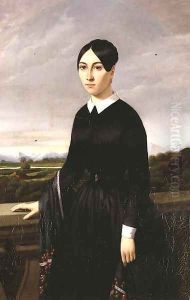Etienne-Constant Carlin Paintings
Etienne-Constant Carlin was a French artist known primarily for his work in the decorative arts, particularly during the latter half of the 18th century. Born in 1753, Carlin's artistic career unfolded during a period of significant change in France, which included the tail end of the Rococo period, the rise of Neoclassicism, and the tumultuous era of the French Revolution.
Carlin's work was characterized by its delicate craftsmanship and intricate design. He specialized in creating small objects of art such as snuff boxes, caskets, and other luxury items that were highly prized among the French aristocracy of the time. These objects often featured detailed scenes and were made from precious materials like gold, silver, and ivory, as well as incorporating porcelain plaques and miniature paintings.
Despite the popularity of his work during his lifetime, Etienne-Constant Carlin's name is not as widely recognized today as some of his contemporaries. This may be due in part to the fact that decorative artists, especially those working on smaller, more intimate objects, often do not receive the same level of historical attention as painters or sculptors of grander works. Nevertheless, Carlin's contributions to the decorative arts of the 18th century reflect the exquisite craftsmanship and artistic trends of his time.
Not much is known about Carlin's personal life or training, but his works suggest that he was well-versed in the artistic styles and techniques of his era. The decline of the French aristocracy and the social upheavals of the Revolution likely impacted his clientele and may have led to changes in his artistic production. Etienne-Constant Carlin died in 1812, leaving behind a legacy of artistry that offers insight into the aesthetics and culture of pre-revolutionary France.
